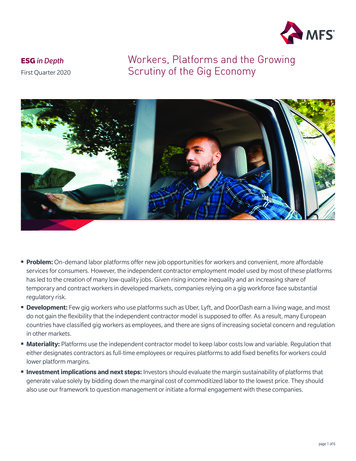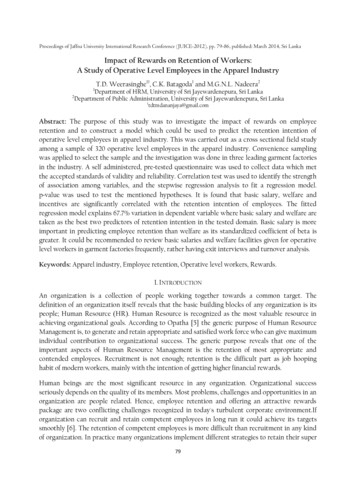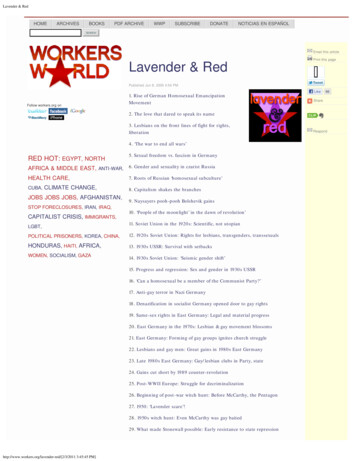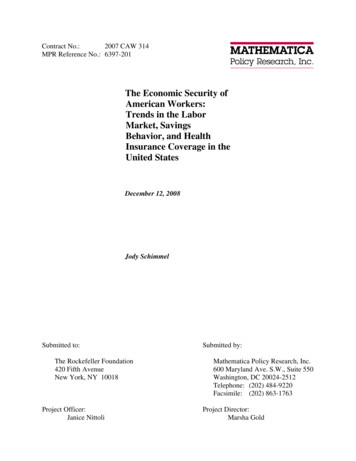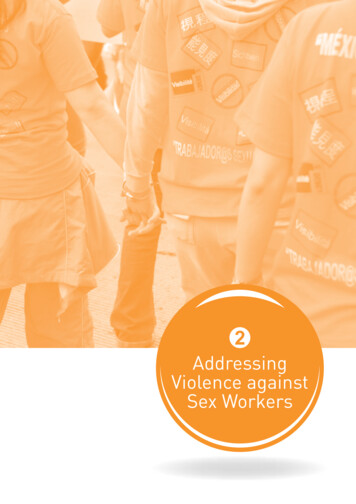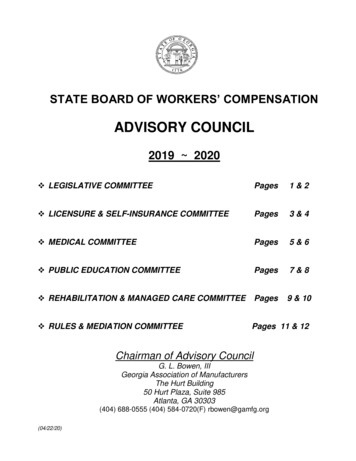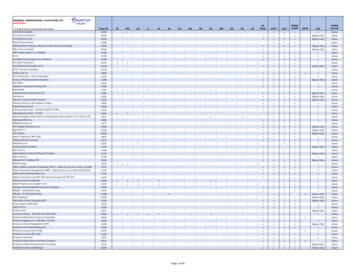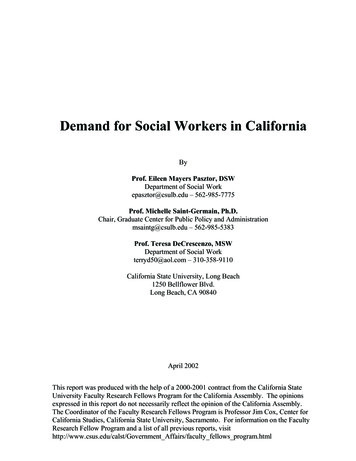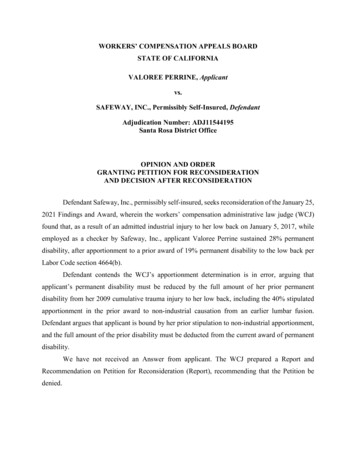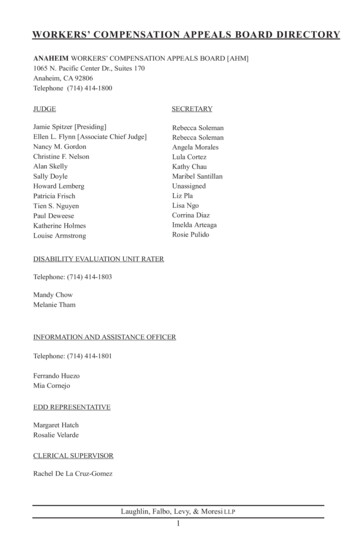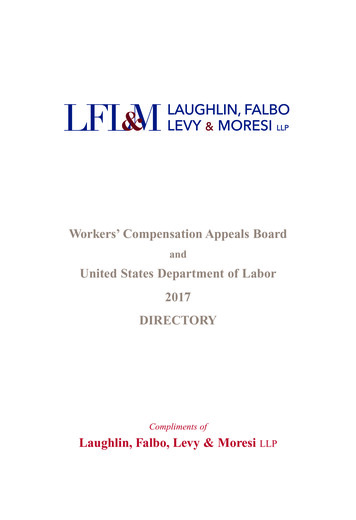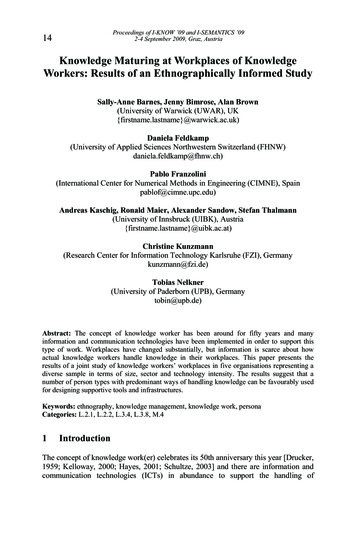
Transcription
Proceedings of I-KNOW ’09 and I-SEMANTICS ’092-4 September 2009, Graz, Austria14Knowledge Maturing at Workplaces of KnowledgeWorkers: Results of an Ethnographically Informed StudySally-Anne Barnes, Jenny Bimrose, Alan Brown(University of Warwick (UWAR), UK{firstname.lastname}@warwick.ac.uk)Daniela Feldkamp(University of Applied Sciences Northwestern Switzerland (FHNW)daniela.feldkamp@fhnw.ch)Pablo Franzolini(International Center for Numerical Methods in Engineering (CIMNE), Spainpablof@cimne.upc.edu)Andreas Kaschig, Ronald Maier, Alexander Sandow, Stefan Thalmann(University of Innsbruck (UIBK), Austria{firstname.lastname}@uibk.ac.at)Christine Kunzmann(Research Center for Information Technology Karlsruhe (FZI), Germanykunzmann@fzi.de)Tobias Nelkner(University of Paderborn (UPB), Germanytobin@upb.de)Abstract: The concept of knowledge worker has been around for fifty years and manyinformation and communication technologies have been implemented in order to support thistype of work. Workplaces have changed substantially, but information is scarce about howactual knowledge workers handle knowledge in their workplaces. This paper presents theresults of a joint study of knowledge workers’ workplaces in five organisations representing adiverse sample in terms of size, sector and technology intensity. The results suggest that anumber of person types with predominant ways of handling knowledge can be favourably usedfor designing supportive tools and infrastructures.Keywords: ethnography, knowledge management, knowledge work, personaCategories: L.2.1, L.2.2, L.3.4, L.3.8, M.41IntroductionThe concept of knowledge work(er) celebrates its 50th anniversary this year [Drucker,1959; Kelloway, 2000; Hayes, 2001; Schultze, 2003] and there are information andcommunication technologies (ICTs) in abundance to support the handling of
S.-A. Barnes, J. Bimrose, A. Brown, D. Feldkamp, P. .15knowledge, informal or workplace learning. One can assume that there have beenlarge changes in workplace organisation due to increasing penetration with ICTs.However, there is a notable shortage of studies that analyse what is going on inorganisations in terms of workplace learning and how guidance of these collaborativeknowledge and learning activities could be designed. Furthermore, empirical dataabout maturing of knowledge within organisational settings cannot be found in theliterature. This paper presents the results of a collaborative ethnographically informedstudy which investigated workplaces of knowledge workers from a knowledge(maturing) perspective. In the following, the paper first gives an overview of theprocedure taken in the study and the analysis of its results. Section 3 presentsindividual studies and selected results, specifically so-called personas and cases thatare described from a knowledge maturing perspective. Section 4 then reports on theprocedure we took to consolidate the results found in the individual studies as well asits outcome. Finally, section 5 concludes the paper and gives an outlook to thestudies’ further (potential) usage.2ProcedureEthnographical research established in anthropology and social science wasdeveloped to investigate new cultures and social settings. The key characteristic ofethnography is active participation in social settings to understand why things happen[Jordan, 1996; Fetterman, 1999; Lamnek, 2005]. In contrast to field observationwhich describes what happens, ethnography focuses also on the why and how thingshappen. The researcher tries to become a member of the community by working withpeople in their natural environments, typically for long periods of time [Fetterman,1999]. Recently, ethnography has become more popular also in disciplines other thananthropology and sociology. For example in computer science, ethnography has beenone of the key approaches for designing CSCW (computer supported cooperativework) systems [Harper, 2000]. In order to balance the need for an in-depthunderstanding of why, how and in what ways technology affects work practices in thefast-changing world of information systems which calls for ethnographic studies withthe substantial efforts and time that this type of empirical work requires, modifiedversions, like rapid ethnography [Millen, 2000], have been proposed to be moresuitable in requirements analysis [Harper, 2000]. The main idea of that modifiedethnography is to save time by narrowing the focus, use several observationtechniques, work collaboratively and use tools for the analysis [Millen, 2000].The term collaborative ethnographically informed study might fit better to ourstudy because we performed five studies with joint perspective and guidance adheringto ethnographic fieldwork as much as possible. The time allocated had to be limited tofour weeks each, though, and divided as follows:1st week: At least two researchers visited each organisation to undertake theethnographic fieldwork and to gain an understanding of knowledge maturing.2nd-3rd week: Ethnographers were in contact, e.g., via e-Mail, instant messagingor telephone, with participating knowledge workers. Self-reporting was used forgaining data about specific and well-defined topics over the two week period.
16S.-A. Barnes, J. Bimrose, A. Brown, D. Feldkamp, P. .4th week: The same researchers returned to the organisation for furtherethnographic fieldwork. They discussed the topics of self-reporting, gained a richerpicture of organisational activities and interview selected individuals.This fieldwork provided us with rich qualitative empirical material which wascoded, reflected and analysed. Numerous face-to-face workshops and teleconferenceswere held with the ethnographic teams in order to jointly interpret the data. A numberof distinctive results were found, specifically knowledge maturing routines, cases,processes as well as personas.Modelling personas is one promising approach to characterise user needs, workroutines and learning styles as proposed by [Cooper, 1999]. A persona is a precisedescription of a user’s characteristics and what he/she wants to accomplish [Cooper,1999] and represents a class of target users that is described with rich information[Aoyama, 2007]. Besides its usage for software designers, personas can be used forcommunication with clients and stakeholders [Chang, 2008]. There is a plethora ofrelated work investigating personality types from a psychological perspective [Bayne,2004; Bayne, 2005; Bayne, 2006]. However, general personality types have not beenanalysed from a learning perspective and, thus, do not focus on how individualshandle knowledge (maturing), which was the main research interest for theethnographically informed studies. Personas form important communication mediawithin the team of designers [Blomquist, 2002]. They are useful in helping to guidedecisions about a product, such as features, interactions, and visual design.3Results of Individual StudiesThis section provides an overview of results of the ethnographically informed studiesconducted at six organisations selected for diversity in terms of size, sector andtechnology intensity (names of organisations are pseudonyms). Table 1 provides anoverview of the organisations studied.
17S.-A. Barnes, J. Bimrose, A. Brown, D. Feldkamp, P. .organisationsizesectorcountryIT yees)large (20,000employees)IT servicesGermany# ethnographers3health rryAndrewBeckyColinDeborahHealth CareTraining andConsultingTelecommunicationProviderIT Franchisingmedium (130employees)CareersGuidanceServices Ilarge( eersGuidanceServices IIlarge( -learning ilkeCarolinaRaquelTable 1: Studied organisationsEach of the following sections contains a short description of the observedorganisation as well as a summary of collected results and presents two selectedoutcomes: (1) one persona developed to represent ‘typical’ employees; and (2) aselected description of short-term, individual, and situational as well as long-term,more procedural knowledge maturing cases involving many organisational membersor even units.3.1Study I: IT Service Provider (ITSP)ITSP is specialised on SAP solutions for utility companies and employs 400 staff.ITSP operates a computing centre, is an outsourcing provider and has administration/hosting, consultancy, development and application support teams. Nine employeeswere studied by three ethnographers who aggregated characteristics of severalknowledge workers and created three personas: Aisha, the anchorwoman; Igor, thecommunicative type and Sally, the do-it yourself type (names again are pseudonyms).Igor, a persona which represents a communicative type could be identified andbased on real-world individuals working as technical consultants directly withcustomers. Igor works as an IT consultant in the consulting department and his manyof his daily tasks are not standardised. He works in different project teams and has to
18S.-A. Barnes, J. Bimrose, A. Brown, D. Feldkamp, P. .continuously acquire new knowledge, especially about clients’ circumstances. If Igorhas a problem and he needs knowledge to solve it, his first approach is to ask peoplecurrently in his room. If nobody in the room has a reasonable answer or knowsanother person who can help, he initiates a discussion about the topic regardless ofwhat tasks his colleagues are currently engaged in. In many cases, solution ideascould be generated or the discussion team can refer to somebody. Igor has a goodnetwork and maintains relationships with other people. He uses breaks to getinformation about other people’s work and activities or to discuss own workproblems. Thus, he has a comprehensive picture of ongoing activities and isconstantly well informed. His motto is “There are no stupid questions, only stupidanswers.”One long-running case being an example for a maturation of knowledge is theprocess describing the introduction and development of the portal technology. Theprocess started with the employment of a university alumni interested in portaltechnology. He sparked interest by his team leader and his head of department who lethim pursue the topic. After searching for existing information within the company, bythe vendor of the solution and talking to colleagues, the portal technology was foundto be promising. He was sent to a training course by the software vendor. It was thendecided to use this knowledge within a pilot project creating a prototype for internaluse. When this project became a success, plans for a commercial solution were madewith the company’s main shareholder as a first customer. The original employeeresponsible for introducing the portal technology became manager of this project. Inparallel, the internal pilot project was enhanced with the effect of further trainingemployees in applying this technology. After successful implementation of thecustomer project, further plans for an enterprise roll-out were made in which theinitial employee was included. With the maintenance of the first productive solution,several challenges within the company arose, which forced changes in the internalprocesses, as this technology needed different support and communication structuresdue to its integrated nature.This case (over a duration of approximately 1.5 years) states a maturation withinthree dimensions: The product knowledge concerning the portal technology and itsdocumentation is developed by several projects. Employees learn about newtechnologies and advance personally. Finally, processes were adapted.3.2Study II: Health Care Training and ConsultingThe second study was conducted at the training and consulting center of a hospitalwith 4,000 employees in total. The studied unit is responsible for organising,planning, and implementing advanced vocational training events (mainly for nurserycare), but also offer mentoring and coaching services; these are for both internal andexternal customers. Five employees were observed by three ethnographers, whichallowed for immersion into everyday activities and training. All have several years ofprofessional experience and a well-developed social network within and outside theorganisation. From the observed individuals, we could aggregate two personas: Silke,characterised by a sense of perfectionism, and Otto, exemplifying the impact oforganisational constraints and the behaviour of his superior on motivation.Silke had completed her academic studies after a vocational training. She stilltries to stay in contact with her former occupational group in order to stay up-to-date
S.-A. Barnes, J. Bimrose, A. Brown, D. Feldkamp, P. .19with practice. For her, it is essential to have clear structures for the paper-based anddigital part of her workplace. These structures are both based on subject (as a kind ofreference book) and chronological (for business transactions). This applies both todocuments and emails. Although currently these structures and document archives aremostly used by her alone, she would also like to have access to similar sources of hercolleagues in order to avoid redundant work. She finds shared folder structures withseveral levels difficult to use because the criteria for structuring are not always herown. Also, labelling of files is frequently a source of problem. She also has a deepconcern about data safety and, thus, keeps an archive of all documents in paper form.When working on her emails, she always checks all mails in the spam mail folder inorder not to lose any message. She often has problems with the usability of computersoftware. Clear structures within applications that do not change with softwareupdates are crucial as she lacks deep knowledge about comput
the vendor of the solution and talking to colleagues, the portal technology was found to be promising. He was sent to a training course by the software vendor. It was then decided to use this knowledge within a pilot project creating a prototype for internal use. When this project became a success, plans for a commercial solution were made
